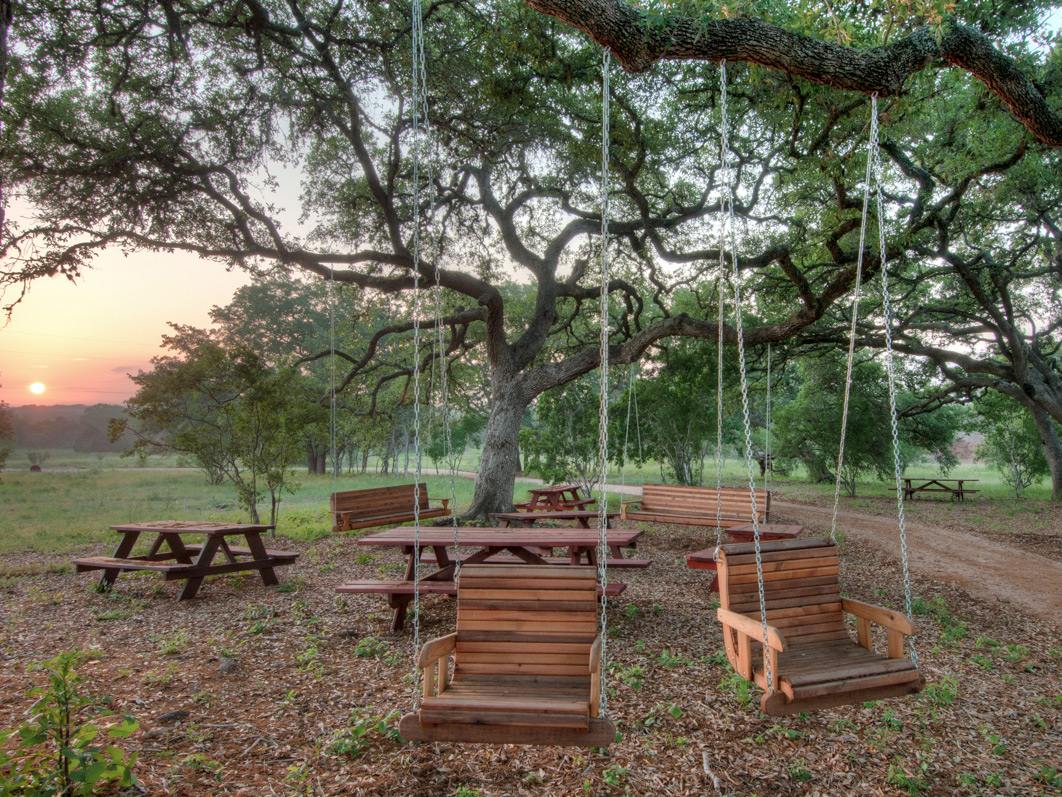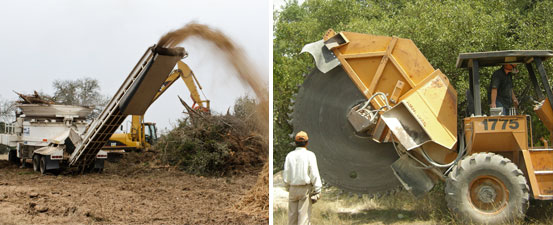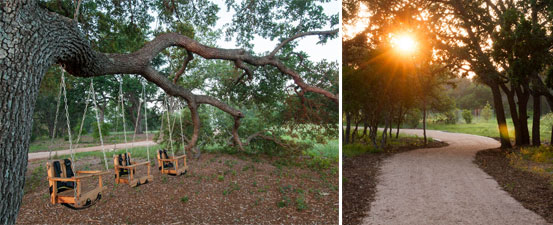The Making of the Texas Arboretum

Swings under the Cathedral Oaks in the Texas Arboretum. PHOTO Wildflower Center
WHEN IT OPENED ON MAY 19, 2012, the Wildflower Center’s Mollie Steves Zachry Texas Arboretum made history as Texas’ largest native plant arboretum. To the Center’s own historic timeline, it added the completion of the largest construction project taken on by the organization since the new site in southwest Austin was built in 1995.
A visit to the Arboretum — that nearly doubles the Center’s managed footprint on the 279-acre site — however, will not give the sense that something was “built” here. The red oaks, cedar elms and other magnificent trees — some of them more than 100 years old — provide a peaceful, natural backdrop for an expansive native meadow and shade for picnic areas throughout the 16-acre site. All but 150 of the trees were on site before development began.
In fact, Center Senior Director Dr. Damon Waitt found that building the arboretum from leading landscape architect W. Gary Smith’s ambitious design was like working on an old painting with a painting underneath and another underneath that. So rather than seeing the construction process as building, he thinks of it as discovery.
“When we first started preparing the site we used heavy equipment — broad brush strokes — to remove decades-worth of overgrown cedar (Ashe juniper). As we peeled back the first layer to reveal majestic live and post oaks we switched to fine brush strokes using hand tools to refine our approach,” says Waitt.
Center Collections Manager Joe Marcus removed the first layer in 2007 when the first machine touched down on degraded ranchland. “I spent about a week out there mowing all ‘mowable’ areas of the site with a big shredder just so that we could get around through the overgrown Ashe juniper,” says Marcus.
The early days of construction were largely consumed by managing and removing those juniper trees in an effort to shine light on the historic live oak and post oak savanna and cedar elms they’d crowded out. Without significant funding at that point, progress was slow and depended on the kindness of friends and existing staff who worked juniper management into their already tight schedules. Marcus recalls that in 2008 a Center friend loaned two Bobcats® and a couple of men for several weeks just to clear juniper.

LEFT Drum grinder at work turning Ashe juniper into mulch. RIGHT Rock saw preparing to dig oak wilt trench.
“We made big piles of juniper brush. About a year later somehow we had some money and we hired a company to come in with a truck grinder and grind all those trees into mulch. That mulch is now used around the Arboretum’s new plantings,” he says.
Everything changed in 2010 when Mollie Steves Zachry generously contributed her $1.4 million gift, made from an anonymous fund of the San Antonio Area Foundation at her request. The pace picked up, and the trails and irrigation systems Marcus and Waitt had anticipated were developed. New trees were secured. One full-time and one part-time arborist were hired.
A $470,000 construction budget still meant that the staff had to be resourceful and creative — and experienced. A second generation arborist and irrigator, Site Manager Phillip Schulze was raised on a tree farm in Schumansville, Texas. His crew — Andrew McNeil-Marshall (the Center’s first full-time arborist), Nick Richman and Jon Merz — were first on contract to the Center before becoming employees.
Schulze says they’ve all grown professionally because of this project. “Most importantly we have greatly advanced our tree care program at the Wildflower Center. Tree care has become a higher priority not just at the Texas Arboretum but across the entire Wildflower Center.”
There were ample opportunities to grow professionally, says Marcus who uses one word to describe the construction process: self-perform.
“We would bid out certain jobs to contractors, and when prices came in too high we would choose to build it ourselves,” says Marcus. “That is impressive because within our staff we had the expertise, knowledge and experience to perform this major undertaking.”
One of the biggest jobs they took on was the Texas Arboretum’s irrigation system. “I knew from the start that we couldn’t have an arboretum without an irrigation system,” says Marcus, who explains that irrigation is only for the trees — not the entire site — and that hand watering was not feasible because of the distance between trees.
Marcus designed the system, and Schulze and his crew installed the four miles of irrigation line. That meant trenching 18,000 feet down to two feet and laying the irrigation pipes within the ground.

LEFT Baby swings in the Cathedral of Oaks. RIGHT Arboretum trail at sunset.
The digging did not stop there. When Schulze discovered oak wilt — a disease already affecting oaks on the site — the Texas Forest Service came out and recommended that staff dig 1,500 feet of trench five feet deep. “Within the boundaries of that trench we removed all the oaks susceptible to oak wilt,” says Waitt. “We had to remove the trees, allow the roots time to die (oak wilt doesn’t live in dead tissue) and safely replant. We also removed all vegetative material between the trench and the oak wilt infestation since oaks between the trench and the oak wilt were possible transmission vectors.”
When the site was opened up to reveal a scenic savanna of cedar elm, live oak and post oak interspersed by grassland, it was time to implement the design elements that would put all that beauty within visitors’ reach. ADA-compliant, 8-feet wide main trails and 6-feet wide side trails do that. The Texas Arboretum’s trails differ from trails in other areas of the Center because they are curbed — which adds a clean, formal look and reduces maintenance needed to remove weeds.
When staff and volunteers — Schulze has 10 ongoing regulars and there have been scores of others — weren’t digging through rocky earth or swinging from branches, they were out scouting trees. Marcus traveled the state to secure trees from nurseries specializing in native plants. In Fall 2010, he collected acorns from a number of famous and historic oak trees throughout Central and South Texas for the arboretum’s Hall of Texas Heroes exhibit.
“We are collecting acorns of historic trees from around the state, growing them in our tree nursery and planting them in the Hall of Texas Heroes,” explains Waitt.
But even with all that’s been done, Waitt says the canvas won’t ever really be complete. “This is a work in progress that will span our careers and the careers of the next generation of Wildflower Center botanists and arborists. We will always be out there looking for new and interesting woody plants to add to the arboretum. It took 200 years to get this far and it will be another 20-30 years before the trees we plant today reach their full glory.”
With so much heavy lifting behind him, Schulze says, “I’m impressed that we were able to transform such a rough site into the beautiful area that it is now,” he says. “Construction was a process of revealing the natural beauty of the site, while creating space to grow lots of trees in the future and making it accessible to people.”
Accessibility is key since Waitt sees the arboretum as the spot for tree-related events, programming and research. He also sees it as a place for Austin residents and visitors to come and enjoy a park-like setting. “They can climb a tree, fly a kite, relax.”
With the hardest part of arboretum creation behind them, so can the staff.
The Mollie Steves Zachry Texas Arboretum was developed with donated time or materials from: Advisory Council Member Melissa Jones of Austin; Eagle Scouts such as John Michael Reyes; They Might Be Monkeys!; We Love Trees; the Texas Chapter of the International Society for Arboriculture; Betsy Rogers and the C.L. Browning Ranch; The University of Texas at Austin’s Landscape Services; the Susan Vaughan Foundation, the Texas Forest Service; Austin Energy; Pedernales Electric Cooperative; Sul Ross State University; volunteers from NRG Energy Inc., Entercom Austin, and Whole Foods; G4 Spatial Technologies, and the Stanley Smith Horticultural Trust.
Learn more about the Texas Arboretum and the trees and plants within it here.

